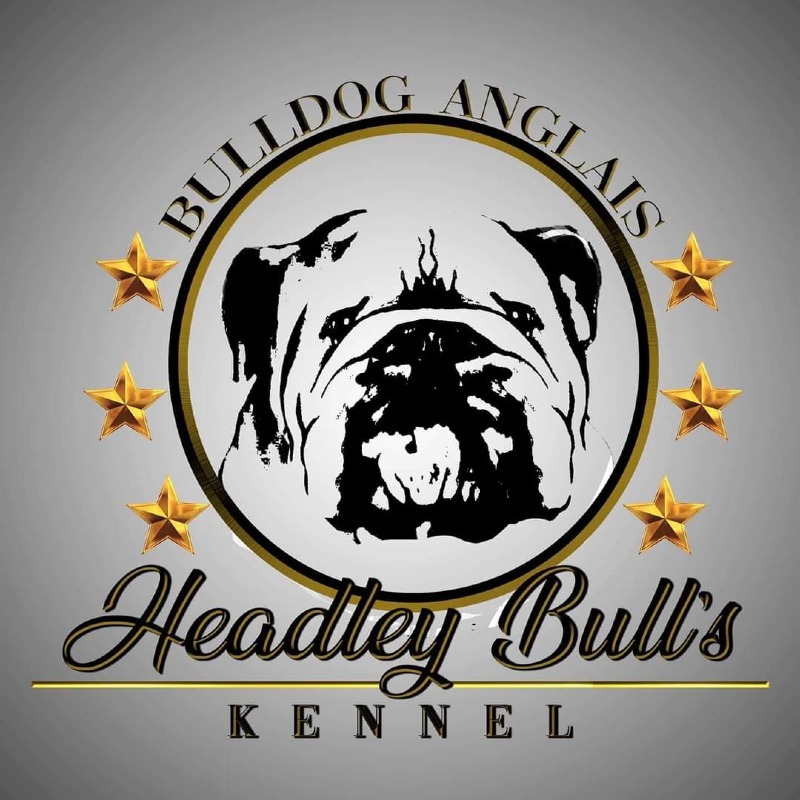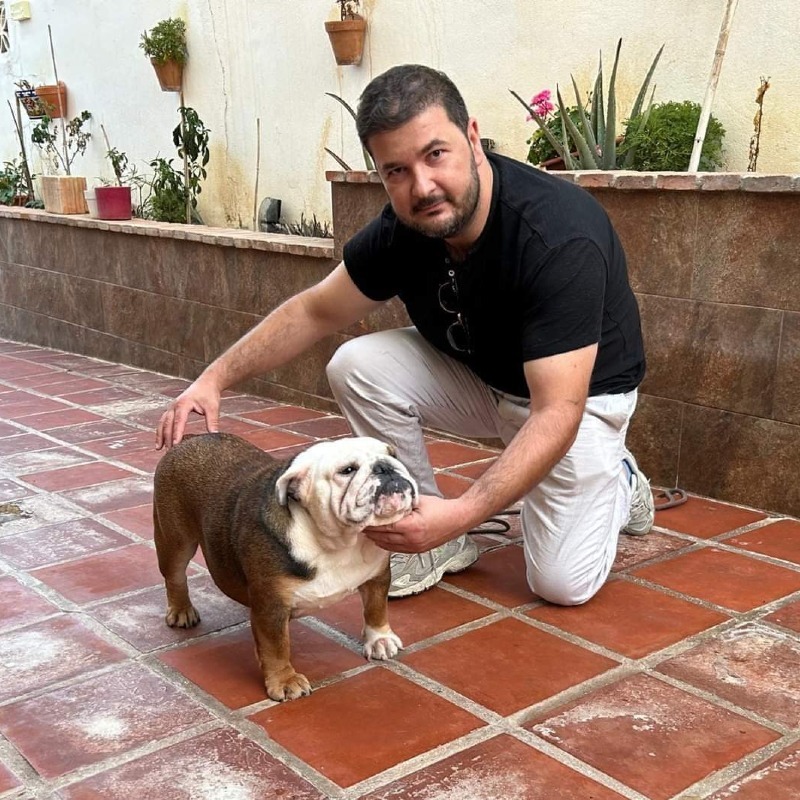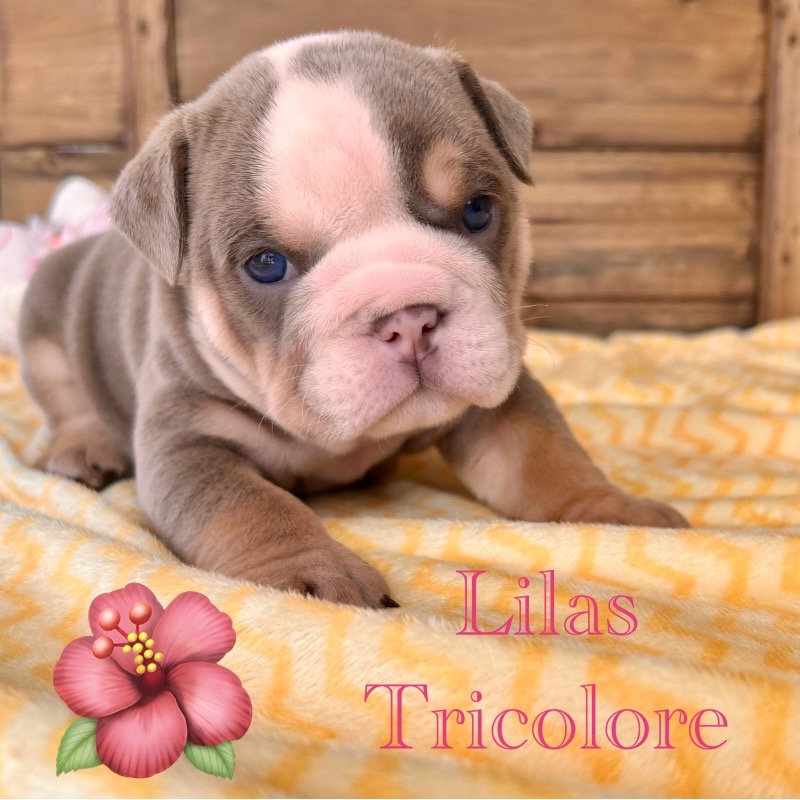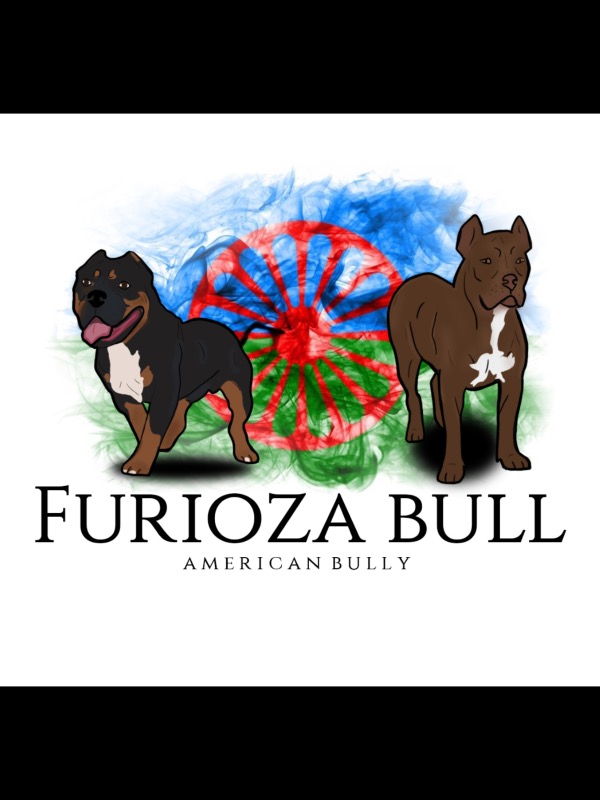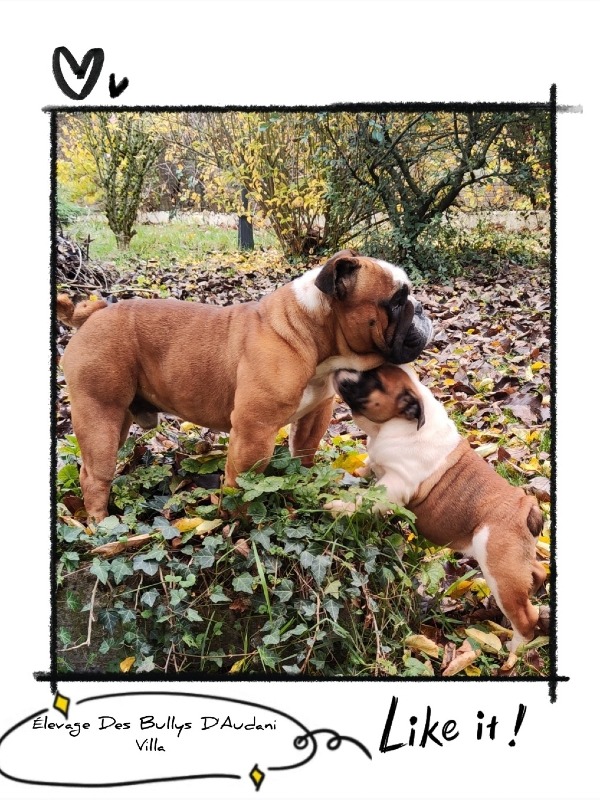English bulldog
Welcome to our page dedicated to the breed of dog english bulldog!
Here, you will find all the useful information about english bulldog. This descriptive profile will allow you to discover the aspects of this breed. You can notably consult information about the average price, monthly and annual upkeep expenses, their health, name ideas, as well as their official recognition by competent authorities.
Explore this page to discover everything you need to know.
Overall description of the breed
The English Bulldog, as its name suggests, originated in England in the 15th century, at which time it was mainly used as a fighting dog, selected and worked with the specific aim of being able to compete with bulls in the arena. The dog fighting sessions called "BullBaiting" was very popular in the UK, until it was banned in 1837, it got its name precisely from its former activities, with the prefix "Bull" meaning bull. After the ban, the English Bulldog became fierce and combative and was abandoned in favour of other less aggressive dogs, with little breeding and more breeders to maintain its gene pool. The English Bulldog was on the verge of extinction at the end of the 19th century, but a number of enthusiasts decided to resume breeding and set up a rigorous selection process in order to make it a pleasant and trustworthy companion dog, a gamble that has paid off, as today it is one of the most affectionate breeds. Extremely popular in Europe and the United States, the breed was finally registered by the International Cynological Federation on March 14, 1955, and its official standard was published on October 13, 2010.
The English Bulldog is a massive, heavy and robust dog, with a stocky, square body and little stamina. Its physical abilities are essentially based on power. Rather short on legs, its body must be short and compact, with a centre of gravity placed close to the ground, which gives it enormous vigour and strength. Its head is imposing, its skull and muzzle are dotted with folds, its jaws are pronounced and its lips drooping, giving it a grumpy air, which is its main charm. His eyes are round, located just above his muzzle, which is very short or even flat on some specimens. His two small ears are placed high on the sides of his skull, this one is crossed by a very visible central groove. The English Bulldog is thick-boned, with strong lower limbs and a solidly built body overall. The tail is short or swollen, furnished with abundant hair. The coat is very short with a silky smooth texture, it may be harsh on some specimens. The standard coat colours are: red, fawn, black, fawn and white, other non-standard colours also exist.
Nowadays, the English Bulldog is an ideal companion dog, affectionate and close to its owners, it needs a lot of attention on a daily basis to be well off. Gentle and shy, it is a breed with a sensitive character, always on the lookout for the slightest caress and proof of love from its master. Bulldogs enjoy family activities, provided they are not too intense, especially in the company of children, with whom they are particularly close. Not very athletic, endurance is not one of its primary qualities, however, it will love to share beautiful walks with you, happy in urban or rural environments, it will adapt to you and your lifestyle with great ease. He is very friendly with his owners and does not like to be alone. Improvements can be made if he is well trained from a young age. Like all Bulldogs, he can be stubborn and obedience is not in his genes, but his playfulness and friendliness will win you over. Slightly distrustful of strangers, he will need a short period of adaptation to gain confidence. Faithful and loyal, he will brighten up the daily life of the house with great joy and tenderness.
Adult: The French Bulldog will weigh between 44 to 55 lbs for males and 40 to 50 lbs for females, his height at the withers will be 12" to 14.5".
Awareness of acquiring an animal
Each animal is a sensitive being, deserving love, attention and care.
When you choose to adopt an animal, you take on the responsibility of ensuring its health and well-being throughout its life.
To learn more about animal welfare, we invite you to consult our FAQ by clicking the button below:
Origins
The English Bulldog, also known as Bulldog, has its roots in England. This breed descends from ancient Molossians, powerful dogs used in antiquity for combat and hunting large game. In medieval times, the ancestors of the Bulldog were used for bull-baiting, a bloody sport where dogs fought bulls. With the ban of these practices in the early 19th century, breeders began to modify the breed to make it a more docile domestic companion. Thus, the modern English Bulldog was born, characterized by its friendly nature and distinctive appearance. Today, it is valued for its gentle and affectionate temperament, although it retains a strong appearance of power and robustness.
History
The English Bulldog has a rich and complex history reflecting the evolution of its functions and appearance. In the 18th century, it was mainly used for fights with bulls and other animals, a common and brutal practice in England. When these fights were banned in 1835, the Bulldog nearly disappeared. However, thanks to passionate breeders, the breed was preserved and transformed into a companion dog. Over the decades, breeders focused on developing a gentler temperament while retaining characteristic physical traits such as the smashed muzzle and stocky body. Today, the English Bulldog is one of the most popular breeds in the world, known for its loyalty and affection towards its owners.
Standard
The standard of the English Bulldog breed is rigorously defined by canine control organizations such as the Fédération Cynologique Internationale (FCI) and the American Kennel Club (AKC). The English Bulldog must have a powerful, compact, and robust appearance. Its head is broad and massive, with a short muzzle and a characteristic, often wrinkled face. The eyes should be round and well-spaced, dark in color. The ears are small and rose-shaped. The body is short and muscular, with a broad chest and strong shoulders. The legs are straight and well-muscled, and the tail is short, often curled or straight. The coat is short, smooth, and dense, available in a variety of colors, including white, brindle, fawn, and pied. These standards ensure the authenticity and quality of the breed.
Physical characteristics
The English Bulldog is a medium-sized dog, generally measuring between 31 and 40 cm in height at the withers. Males weigh between 24 and 25 kg, while females weigh between 22 and 23 kg. The Bulldog's coat is short, smooth, and shiny, requiring minimal grooming. Coat colors vary and include white, fawn, brindle, and combinations of these colors. The Bulldog's body is compact and muscular, with a broad chest and powerful shoulders. Its massive head features a short muzzle and a wrinkled face, giving it a unique and recognizable expression. The ears are small and rose-shaped, while the tail is short and often straight or slightly curled.
Character
The English Bulldog is known for its gentle and affectionate temperament. It is extremely loyal to its family and often very patient, making it an excellent companion for children. Despite its sturdy appearance, it is generally calm and obedient, preferring to relax at home rather than engage in intense activities. This dog is also very courageous and protective, not hesitating to defend its loved ones in case of danger. The Bulldog can sometimes be stubborn, but with proper training, it is obedient and eager to please. Its loving and devoted nature makes it an excellent pet for many families.
Life expectancy
The life expectancy of an English Bulldog is relatively short compared to other dog breeds, generally ranging between 8 and 10 years. Several factors can influence this duration, such as genetics, lifestyle, nutrition, and medical care. It is essential to provide this dog with regular veterinary care and closely monitor its health, due to its predisposition to certain hereditary health problems. A balanced diet, moderate exercise, and a healthy living environment can help improve the quality of life and potentially extend the life expectancy of this sturdy but sensitive dog.
Exercise and activity needs
The English Bulldog has moderate exercise needs. Due to its sturdy build and short muzzle, it is not suited for intense or prolonged physical activities. One to two daily walks of about 20 to 30 minutes each are generally sufficient to meet its needs. In addition to walks, some play sessions at home or in a secure garden are recommended to mentally and physically stimulate the dog. It is crucial to avoid exercise in hot weather, as the English Bulldog is prone to heat stroke due to its breathing difficulties. A balance between activity and rest is essential to maintain its health and well-being.
Recommended diet
The English Bulldog's diet must be balanced and of high quality to meet its specific nutritional needs. It is recommended to prioritize food rich in proteins and essential nutrients, while avoiding excess fats and carbohydrates. An adult Bulldog typically consumes between 200 and 300 grams of kibble per day, divided into two meals. The monthly cost of feeding an English Bulldog generally ranges between 50 and 100 euros, depending on the quality of the kibble and any potential dietary supplements. Special attention should be paid to their weight, as this breed is prone to obesity, which can worsen existing health problems.
Training and obedience
Training and educating an English Bulldog requires patience and consistency due to its sometimes stubborn nature. It is recommended to start training from a young age, using positive methods based on rewards. Early socialization is crucial to help the dog develop good manners and get used to various situations, people, and other animals. Training sessions should be short and varied to maintain the dog's interest. Repetition and consistency are essential to reinforce desired commands and behaviors. With proper education, the English Bulldog can become a well-behaved and obedient companion.
Behavior with children
The English Bulldog is generally excellent with children. Its gentle and patient nature makes it an ideal companion for families. It shows affection and protection towards the youngest members, often tolerating their sometimes rough behavior with great indulgence. However, as with all dogs, it is essential to supervise interactions between the Bulldog and children, especially at a young age, to prevent any accidental incidents. Teaching children to respect the dog and to interact with it appropriately is crucial. Thanks to its loyalty and stable temperament, the English Bulldog is often seen as a full-fledged family member.
Compatibility with Other Animals
The English Bulldog can get along well with other pets, especially if socialized from a young age. In general, they show a friendly and tolerant nature towards other dogs and even cats. However, each Bulldog has its own personality, and some may be more territorial or possessive. A gradual and supervised introduction is recommended when a new animal companion is introduced into the home. With proper socialization and adequate supervision, the English Bulldog can live harmoniously with various pets, thereby contributing to a peaceful and balanced home.
Grooming needs
The English Bulldog requires regular grooming to maintain its short and smooth coat in good condition. Weekly brushing is sufficient to remove dead hair and keep the coat clean and shiny. It is important to pay special attention to the skin folds, especially around the face, by cleaning them regularly to prevent infections. Baths can be given every two months or as needed, using a gentle dog shampoo. Additionally, it is essential to regularly check and clean the ears, trim the nails, and brush the teeth to maintain overall hygiene.
Health
The English Bulldog is subject to several hereditary health issues and those related to its particular morphology. Respiratory conditions, such as brachycephalic syndrome, are common due to its flattened muzzle. Skin problems, like infections in skin folds, require regular attention. This breed can also suffer from hip dysplasia, heart issues, and obesity. A balanced diet, moderate exercise, and regular veterinary visits are essential to manage these risks. Due to its potential health problems, the English Bulldog requires attentive veterinary care to ensure a good quality of life.
Average price
The average price of an English Bulldog varies considerably depending on several factors, including the quality of breeding, the pedigree of the parents, and the geographical location. Generally, the cost of an English Bulldog puppy can range between 1500 and 3000 euros. Puppies from champion lines or reputable breeders can be even more expensive. It is important to be wary of prices that are too low, as they may indicate irresponsible breeding practices or health issues. Investing in a quality puppy from a reputable breeder not only ensures a healthy dog but also provides support in terms of advice and post-adoption follow-up.
Expenses
Monthly expenses for an English Bulldog can vary, but they generally include food, veterinary care, health insurance, and various accessories and toys. On average, these expenses can range between 100 and 200 euros per month. Quality food, regular veterinary checks, and preventive treatments against parasites are significant parts of these costs. Additional expenses may include grooming, although this is relatively minimal for this breed. Investing in pet health insurance can also help manage unexpected costs related to veterinary care.
Name ideas
Choosing a name for an English Bulldog can reflect its unique personality and distinctive appearance. Here are some name suggestions: Bruno, Bella, Diesel, Daisy, Max, Molly, Rocky, Rosie, Winston, Lola, Tyson, Lucy, Duke, Ruby, Gus, Zoey, Charlie, Sadie, Hank, Olive. These simple and easy to remember names are well suited for this breed. Whether you choose a classic, modern, or even humorous name, the important thing is to choose a name that resonates with you and your new companion.
Legislation and regulation
In France, the English Bulldog is not classified among dangerous dog breeds, which means that it is not subject to any specific regulations beyond general rules concerning dogs. However, it is essential to comply with local dog laws, such as registering with the town hall and vaccination requirements. In other countries, regulations may vary, but the English Bulldog is generally exempt from restrictive classifications. It is always advisable to check local laws on dog ownership, especially when moving or traveling internationally.
Official recognition
The English Bulldog is recognized by many cynological organizations around the world. Among them, the Fédération Cynologique Internationale (FCI), the American Kennel Club (AKC), the Kennel Club in the United Kingdom, and the Société Centrale Canine (SCC) in France. These organizations define the breed standards and organize competitions and shows to promote the quality and preservation of the breed. Official recognition by these organizations guarantees that the English Bulldog meets strict criteria for health, behavior, and morphology, thus ensuring the preservation of its unique characteristics.
Pedigrees
The pedigrees of the English Bulldog are managed by various recognized breed clubs worldwide. In France, the Société Centrale Canine (SCC) is the main organization, while in the United States it is the American Kennel Club (AKC). In the United Kingdom, the Kennel Club fulfills this role. In Australia, the Australian National Kennel Council (ANKC) is responsible, and in Canada, it is the Canadian Kennel Club (CKC). These clubs maintain records of lineages and ensure that puppies sold with pedigrees meet breed standards. Breeders affiliated with these clubs are required to adhere to strict breeding and care rules to ensure the health and quality of the puppies.
Destination and usage
The English Bulldog is primarily bred as a companion dog because of its gentle and affectionate nature. It excels as a family dog, offering loyalty and unconditional love to its owners. Due to its protective and courageous nature, it can also serve as a guard dog, although its size and physical abilities make it less suited to this role than other breeds. Historically used for more brutal tasks like bull-baiting, the modern Bulldog is now valued for its ability to bring comfort and joy to its loved ones, becoming a valuable member of many households.
Prohibitions
The English Bulldog is generally not subject to specific restrictions in terms of ownership or travel. However, some airlines may restrict or prohibit the transportation of Bulldogs due to their respiratory problems, exacerbated by air travel conditions. In addition, some local or regional regulations may impose specific restrictions regarding dog ownership, but the English Bulldog, not being classified among dangerous breeds, often escapes these restrictions. It is advisable to check the specific regulations of each region or country when planning to travel or relocate with an English Bulldog.
Breeders ofEnglish bulldog
Want to see more breeders ofEnglish bulldog?
Check out the page of our directory listing all breeders ofEnglish bulldogClassified Ads ofenglish bulldog
No ofenglish bulldog classified ads are available on Preeders.
If you’re a breeder, sign up for free now and be the first to post a classified ad
Breed clubs ofenglish bulldog
No ofenglish bulldog breed clubs are currently registered on Preeders.
If you would like to highlight your breed club, sign up for free now and be the first to appear on this page.

